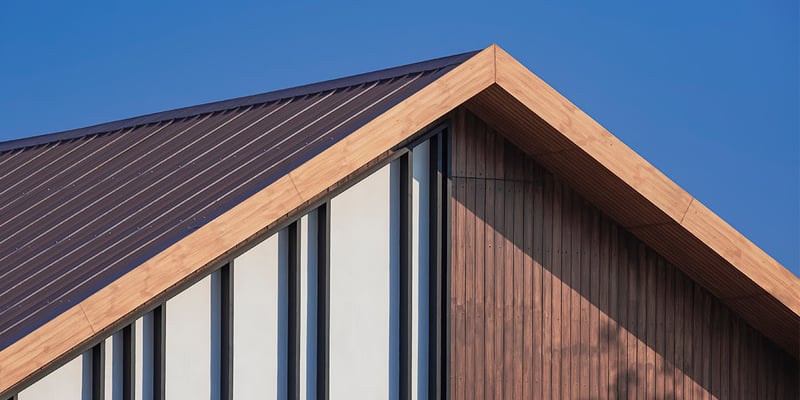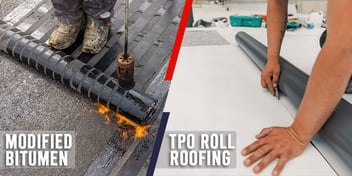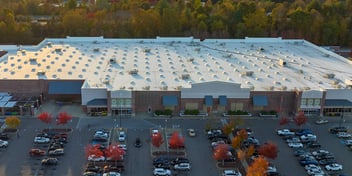- Home »
- Learningcenter »
- Converting flat roof pitched
Is Converting a Flat Roof to a Pitched Roof Worth the Cost?

Are you thinking about giving your home a new look with a roof makeover? I totally get it - changing your roof's shape can really help with the look and performance of your home.
In this article, we'll talk about everything you need to know about replacing your flat roof with a pitched one. If you're trying to help with your home's appearance, help with energy efficiency, or cut down on the constant upkeep flat roofs need - it's a good idea to understand the details of such a big change.
Let's dig into this together. We'll start by checking out the initial costs and then we'll look into the potential benefits you might enjoy down the road.
Calculating the Cost of Conversion
When you start thinking about changing your flat roof to a pitched one, you need to be ready for the financial commitment. I remember when I first looked into it. The numbers really surprised me - you might spend about $35,835 on average, but the costs can range from $15,000 to as much as $56,670. The price varies depending on factors like the size of your roof, the parts used, where your house is located, the difficulty of the structural changes, and the types of finishes.
Switching your roof isn't a quick process, either. It usually takes about four to six weeks for an easy, shallow-pitched roof. If you use a more complicated design, expect it to take even longer. Even though the time and money are involved, the benefits are important: better drainage that stops water pooling, more attic space, or maybe even higher ceilings in some areas. For me - just cutting down on moisture problems makes the investment worth it.

I want to make it clear - this isn't something you can knock out over the weekend. The complexities of this job will need skilled pros. You'll have to think about safety issues, and there are also legal things like building permits that definitely need professional handling.
So, before you jump into this investment, I'd very recommend getting a few quotes. This will give you a better idea of the costs involved and help you find the right contractor. Speaking with pros about what you need can show the real costs. You might even snag a better deal or get advice on how to make the process smoother.
It's a smart investment and a big change that calls for careful planning and expert implementation.
Is There Enough Structural Support?
When you're thinking about turning a flat roof into a pitched one, you have to check if your building can handle the change. It needs to be strong enough to hold up the extra weight of a new roof, right? This is major for keeping future structural problems at a distance and making sure the building stays safe and stable.
First, experts will carefully check your building's latest structure. They'll look at how strong the walls and foundation are to carry the extra load. Based on what they find, you might need some extra reinforcement if things aren't up to scratch. Knowing if your building can support a new roof without extra work can really sway your decision. Especially since improving the structure can be expensive.
Let's say, like this community center that wanted to go from a flat to a pitched roof. At first, it looked easy but then the structural check showed that the foundations and walls needed some serious improvement. They had to put in new steel supports and make the foundations deeper, which bumped up the costs by about 30%. does this kind of work add to your bills but it also makes the whole thing take longer.
And speaking of time, replacing a roof can take four to six weeks. However, this could change depending on the roof size and the complexity of the reinforcements. During this, you might also think about throwing in an extra room or lifting up the ceiling - which could push your property's value up even more.

One of the top benefits of picking a pitched roof is how long it lasts: it's good for about 25 to 50 years, way longer than flat roofs. That was a big deal for me because who doesn't love a roof that hasn't needed much fuss for decades?
Also, changing the roof style can totally spice up how a building looks, boosting its curb appeal and maybe even its market value. While looks aren't as important as the structural and practical benefits, they are definitely a nice plus.
So if you're thinking about this kind of upgrade, remember it's a meaningful decision with lots to think about, especially about structure and costs. But the long-term benefits can definitely make it all worth it.
Permits and Regulations
First off, having a talk with a structural engineer is a good idea. I've learned the hard way that you really shouldn't skip this step. Why, you ask? Well, because pitched roofs are usually heavier than flat ones, and it's important to know if the existing structure can handle the extra weight. It might stretch your budget at the start, but ignoring this could lead to major problems later if it messes with the stability of your building.
Next, you need to pay attention to the building codes. Every area has its own rules, and approaching them early can prevent many headaches. I've realized that my original plans often didn't line up with local laws, which meant starting over more than once. Dealing with this alone can feel like you're walking through a maze.

When it comes to permits, they are pretty important, and the process for getting them can basically depend on where you're. I've found it helpful to visit your local building authority or their website to get all the needed information. Keeping everything coordinated can really smooth out the process and help you avoid expensive delays or legal problems.
Going through these steps has taught me that every choice you make creates a domino effect, affecting everything from your timeline to your budget. This adds layers of difficulty and will need a big commitment of time and some resources. But is it important to make sure everything is up to code and maintains structural integrity? That's super important for me when making such a meaningful change to a property. The important thing is to stay informed and prepared - it'll make the process much easier!
Long-Term Maintenance Needs
When you're thinking about switching from a flat roof to a pitched one, it's smart to think about how this change will help with your maintenance schedule. Usually flat roofs need more upkeep since they like to have issues like water pooling and debris accumulation - they're also more exposed to the wind.
From what I've seen, keeping a flat roof in great condition means checking it at least twice a year. However, pitched roofs are easier to handle, usually just needing an annual check-up unless a big storm rolls through. What a difference, huh? Flat roofs often sustain heat damage and wear out faster because of rough weather - meanwhile, pitched roofs are great at shedding water quickly, which helps prevent problems before they start.

The lifespan of your roof definitely depends a lot on the type: a well-kept flat roof can last from 15 to 30 years. This range varies widely depending on local weather and maintenance consistency. Pitched roofs can last over 30 years with the right care, mostly because they're better equipped to stand up to adverse conditions.
When it comes to repairs, pitched roofs usually have an advantage. Flat roofs might need a few repairs throughout the year, especially if regular maintenance is neglected. These repairs can range from patching leaks to strengthening the structure because of damage from standing water or accumulated debris. In contrast, pitched roofs typically face fewer issues, needing only occasional fixes like replacing a cracked shingle or sealing a leak near the flashing.
If you use a pitched roof, establishing a regular check-up schedule is a good idea decision. Also, which creates the gutters and downspouts are clear is important - it plays an important part in extending the lifespan and functionality of your roof. Think about having an expert inspect your roof annually to find any issues early, which can save you a great deal on future repairs. It's totally worth the extra effort!
Will a Pitched Roof Help with Home Energy Efficiency?
When you think about switching from a flat roof to a pitched one, you'll see how much it can help cut down on your energy costs. A pitched roof usually does better than a flat roof because it has better ventilation and insulation options.
Let's talk about insulation for a minute. Pitched roofs can fit cavity insulation, which often works better than the membrane or spray foam options that flat roofs use. Putting in solid insulation improves thermal efficiency - making it easier to keep your home comfy. This means you won't have to rely as much on heating or air conditioning, which can really drop your energy bills. Homes with solid insulation in their pitched roofs are great at keeping warm when it gets cold outside.
The design of pitched roofs also helps keep your house cooler. Their sloped shape makes it possible to use reflective parts that bounce back the sun's rays, cutting down on heat buildup. Throw in some strategic shading and your house stays cooler in the summer - now that's a good idea.

Orientation plays a big part, too. The way your roof lines up with the cardinal directions - north, south, east, and west - affects how much sun hits your house and changes the indoor temperature. Pitched roofs that are well-oriented and properly insulated can majorly help with your energy efficiency.
Even though everyone knows pitched roofs are great for snowy places because they shed snow well, the upfront cost of going from flat to pitched can be steep. You're talking about different parts, more complicated construction, and maybe adding things like dormers, which all add to the cost. But when you think about the long-term savings on energy bills and how it could extend your roof's life, it's usually worth it.
In places with harsh weather or extreme conditions, which makes sure your home has the most energy-efficient roof is a good idea. A pitched roof has important insulation and ventilation benefits. If you're looking to bump help with your home's energy efficiency, it's totally worth a look.
Aesthetics and Extra Space
When you start thinking about switching from a flat roof to a pitched roof, you'll immediately notice an important change in how your home looks. I've seen pretty a few homes make this switch and the result is always the same: the house suddenly has more character, depth, and texture - it's pretty the makeover!
This change means you'll have to modify the original roof a bit. Careful planning is super important to make sure the new roof matches the overall architectural style of the house. You need to pick the right parts and find out the best pitch to make sure everything fits nicely with the existing features, keeping both the style and structural integrity of your home.
One great benefit of adding a pitched roof is the extra attic space that changing to a pitched roof brings. This space can be really useful. The amount of space you get depends on the pitch's angle and height - I've seen it turned into bedrooms, home offices, or extra storage space. This makes your home more functional but can also help with its market value - a nice plus if you ever think about selling.

Many homeowners don't initially realize how much a well-done roof conversion can help with their property's value. A good-looking and well-integrated roof can catch the eye of potential buyers and make your house pop in the real estate market. Picking the right parts and roof style is smart, and it's often a great idea to look for professional advice.
Think about this: the addition of a pitched roof can totally revamp a previously plain-looking facade, which will make your house jump out of the neighborhood. The pitched roof draws attention, but it also brings practical benefits like better drainage and more sturdy parts, which make your home more sustainable and functional.
So while it might seem like a look update, switching to a pitched roof adds real value to your home in terms of both aesthetics and how well your home functions. It's worth thinking about, especially if you're looking to step in to help with your living space or when you think about a future sale.
Protect The Roof Over Your Head
Switching from a flat roof to a pitched roof can really spice things up for your home in a good way. It can polish the look, help with functionality, and might even help with your property's market value. The benefits are plentiful: better drainage, extra attic space, improved energy efficiency, and a longer-lasting roof. Now, it's really a good idea to think about this change.
So, is the possible bump in property value and the new look worth the investment for you? Before making such a big decision, think about how it meets your needs and long-term plans for your home.

If you're thinking about this option, it's smart to talk to someone who knows their things. At Colony Roofers, we're all about helping homeowners like you find out these big decisions. We have the expertise and friendly advice you need to make sure your investment and safety are well-managed.
Why not give us a call for a free inspection? We can talk about how switching to a pitched roof could really be incredible for your home. Remember, when you're thinking about a big change like this - it always helps to talk with trusted experts like us at Colony Roofers.
 Call (678) 365-3138
Call (678) 365-3138



